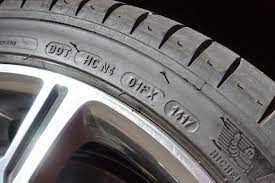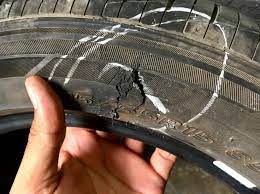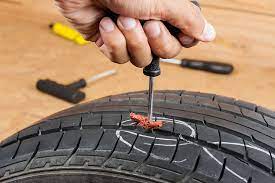Can You Patch a Hole in a Tire Sidewall?
In this article we are going to look more closely at tire damage and most specifically damage done to the sidewall of the tire. We will discuss what can cause it and how you can fix the issue.
What Is a Tire Sidewall?
When we consider the outside aspect of a tire there are two main parts: the tread which is the part that makes contact with the road and the sidewall which does not make contact unless you are unfortunate enough to roll the car on its side.

The job of the tire wall is to protect the cord plies which are strands of polyester cord that run perpendicular to the tire's tread. Essentially the sidewall encapsulates the internal padding of the tire. It also serves as an area on which the tire's manufacturer details and specifications are listed in the form of a coded serial number.
This is not a strong part of the tire so any damage to the sidewall needs to be attended to quickly.
What Can be the Cause of Sidewall Damage?
There can be a number of causes for tire sidewall damage even though this section of the tire does not come into contact with the road surface itself. This part of the tire can still be at risk from sharp objects on the road such as glass and nails.

An old tire that should have been changed may also develop sidewall damage as can a tire that does not have enough air pressure. Below we will list a few potential causes of a damaged tire sidewall.
- Contact with the curb while driving
- Under inflated tire
- Deep potholes
- Sharp objects on the road surface
- A worn tire
- An overloaded vehicle exceeding tire load specs
- Manufacturing defects
Recognizing Tire Sidewall Damage
Some tire sidewall damage is very obvious and other signs can be easily missed. A nail for example sticking out of the sidewall is painfully obvious. Other more subtle signs might be a bubble or a deep scratch/crack in the rubber of the sidewall.
Bubbles and scratches can occur if the side wall rubs against the curb while you are driving and of course punctures in the sidewall can occur from sharp sticks, nails, blass or any other sharp objects that may be on the road.
What Is a Tire Patch?
The good thing about tires is that they are tremendously tough and durable so within reason you can apply a patch to a damaged tire to extend its life helping you avoid the cost of new tires. This tire patch is a piece of rubber with an adhesive backing that will allow it to be glued to the inside of the tire. This creates a seal that prevents the air from escaping from a hole.

Another alternative are tire plugs which rather than covering the hole are actually inserted into the hole. This is again sealed from inside the tire itself creating a protective seal and leaving the tire as close to new as is possible considering the damage.
Can You Patch a Hole in a Tire Sidewall?
You may already have guessed by the description of the sidewall being the weakest part of the tire that it actually can not be patched. If you get a hole or leak in your tire wall there is no point trying to patch this. It simply isn’t strong enough to take the patch and it will fail very quickly.
Patching the sidewall may work briefly but if you try to run on the tire at any kind of reasonable speed you risk a dangerous blow-out. There is no fixing a damaged sidewall you are going to get a new tire which means you will actually need to get at least two because otherwise the uneven tread levels of the new and old tires will cause you issues.
When Can a Tire Be Repaired?
Having told you when a tire can not be repaired we should probably let you know what kind of damage can be fixed just to balance things. The damage will need to meet a certain criteria in order to be fixable so read on to see what that is.
- The puncture must be on the tread area of the tire as this is the toughest and most structural solid section of the tire.
- Any hole must be less than ¼” in diameter; anything bigger than this should not be patched as it may not hold up for very long.
- You can not patch even partially over a former patch job. So if your new patch would overlap another fix this would not work properly.
- The sidewalls must still be sound. Any damage to the sidewalls will make the tire impossible to repair.
How Long Do Tire Patches Last?
If done correctly a good patch job may last the remaining life of the tire. When we say life of the tire we mean the point where the tread has become too shallow to be safe and requires you to get new tires. If the job may not have been perfect you may want to consider replacing the tires when you can afford them in the interest of safety.
Conclusion
The bad news today is that you can’t patch a tire's sidewall; they are simply not structurally sound enough to hold a patch for very long if at all. In good news, however, it is rare to puncture a sidewall and generally speaking as long as you do not under or over inflate your tires you shouldn’t have too many problems with holes.
Link To or Reference This Page
We spend a lot of time collecting, cleaning, merging, and formatting the data that is shown on the site to be as useful to you as possible.
If you found the data or information on this page useful in your research, please use the tool below to properly cite or reference Tow Ratings as the source. We appreciate your support!
-
<a href="http://towratings.net/blog/can-you-patch-a-hole-in-a-tire-sidewall/">Can You Patch a Hole in a Tire Sidewall?</a>
-
"Can You Patch a Hole in a Tire Sidewall?". Tow Ratings. Accessed on July 27, 2024. http://towratings.net/blog/can-you-patch-a-hole-in-a-tire-sidewall/.
-
"Can You Patch a Hole in a Tire Sidewall?". Tow Ratings, http://towratings.net/blog/can-you-patch-a-hole-in-a-tire-sidewall/. Accessed 27 July, 2024
-
Can You Patch a Hole in a Tire Sidewall?. Tow Ratings. Retrieved from http://towratings.net/blog/can-you-patch-a-hole-in-a-tire-sidewall/.